Nandana Mihindukulasooriya
Automatic Prompt Optimization for Knowledge Graph Construction: Insights from an Empirical Study
Jun 24, 2025Abstract:A KG represents a network of entities and illustrates relationships between them. KGs are used for various applications, including semantic search and discovery, reasoning, decision-making, natural language processing, machine learning, and recommendation systems. Triple (subject-relation-object) extraction from text is the fundamental building block of KG construction and has been widely studied, for example, in early benchmarks such as ACE 2002 to more recent ones, such as WebNLG 2020, REBEL and SynthIE. While the use of LLMs is explored for KG construction, handcrafting reasonable task-specific prompts for LLMs is a labour-intensive exercise and can be brittle due to subtle changes in the LLM models employed. Recent work in NLP tasks (e.g. autonomy generation) uses automatic prompt optimization/engineering to address this challenge by generating optimal or near-optimal task-specific prompts given input-output examples. This empirical study explores the application of automatic prompt optimization for the triple extraction task using experimental benchmarking. We evaluate different settings by changing (a) the prompting strategy, (b) the LLM being used for prompt optimization and task execution, (c) the number of canonical relations in the schema (schema complexity), (d) the length and diversity of input text, (e) the metric used to drive the prompt optimization, and (f) the dataset being used for training and testing. We evaluate three different automatic prompt optimizers, namely, DSPy, APE, and TextGrad and use two different triple extraction datasets, SynthIE and REBEL. Through rigorous empirical evaluation, our main contribution highlights that automatic prompt optimization techniques can generate reasonable prompts similar to humans for triple extraction. In turn, these optimized prompts achieve improved results, particularly with increasing schema complexity and text size.
Domain specific ontologies from Linked Open Data (LOD)
May 28, 2025Abstract:Logical and probabilistic reasoning tasks that require a deeper knowledge of semantics are increasingly relying on general purpose ontologies such as Wikidata and DBpedia. However, tasks such as entity disambiguation and linking may benefit from domain specific knowledge graphs, which make it more efficient to consume the knowledge and easier to extend with proprietary content. We discuss our experience bootstrapping one such ontology for IT with a domain-agnostic pipeline, and extending it using domain-specific glossaries.
Scholarly Wikidata: Population and Exploration of Conference Data in Wikidata using LLMs
Nov 13, 2024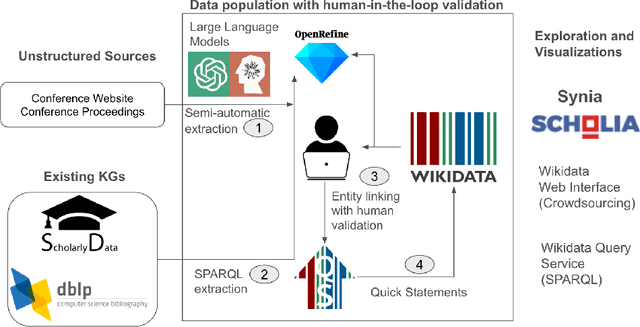
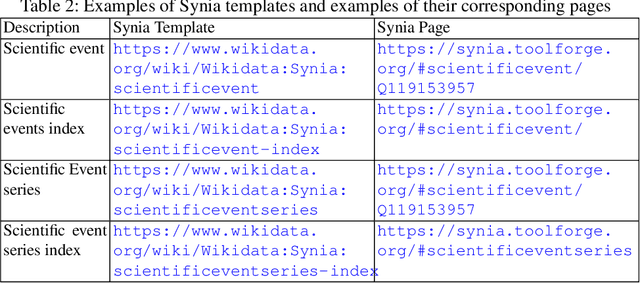

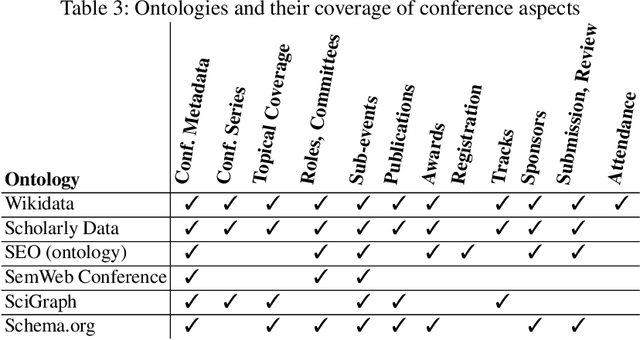
Abstract:Several initiatives have been undertaken to conceptually model the domain of scholarly data using ontologies and to create respective Knowledge Graphs. Yet, the full potential seems unleashed, as automated means for automatic population of said ontologies are lacking, and respective initiatives from the Semantic Web community are not necessarily connected: we propose to make scholarly data more sustainably accessible by leveraging Wikidata's infrastructure and automating its population in a sustainable manner through LLMs by tapping into unstructured sources like conference Web sites and proceedings texts as well as already existing structured conference datasets. While an initial analysis shows that Semantic Web conferences are only minimally represented in Wikidata, we argue that our methodology can help to populate, evolve and maintain scholarly data as a community within Wikidata. Our main contributions include (a) an analysis of ontologies for representing scholarly data to identify gaps and relevant entities/properties in Wikidata, (b) semi-automated extraction -- requiring (minimal) manual validation -- of conference metadata (e.g., acceptance rates, organizer roles, programme committee members, best paper awards, keynotes, and sponsors) from websites and proceedings texts using LLMs. Finally, we discuss (c) extensions to visualization tools in the Wikidata context for data exploration of the generated scholarly data. Our study focuses on data from 105 Semantic Web-related conferences and extends/adds more than 6000 entities in Wikidata. It is important to note that the method can be more generally applicable beyond Semantic Web-related conferences for enhancing Wikidata's utility as a comprehensive scholarly resource. Source Repository: https://github.com/scholarly-wikidata/ DOI: https://doi.org/10.5281/zenodo.10989709 License: Creative Commons CC0 (Data), MIT (Code)
Research Trends for the Interplay between Large Language Models and Knowledge Graphs
Jun 12, 2024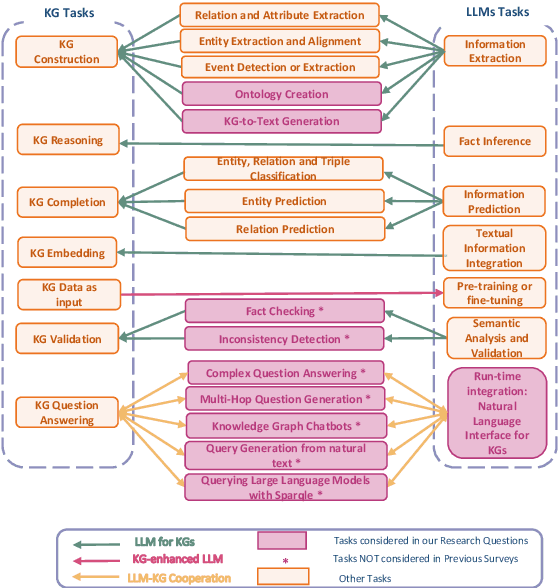
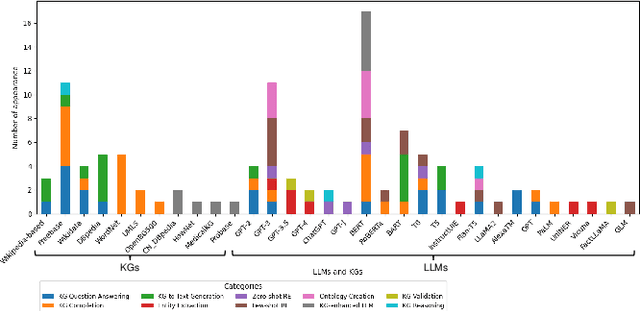
Abstract:This survey investigates the synergistic relationship between Large Language Models (LLMs) and Knowledge Graphs (KGs), which is crucial for advancing AI's capabilities in understanding, reasoning, and language processing. It aims to address gaps in current research by exploring areas such as KG Question Answering, ontology generation, KG validation, and the enhancement of KG accuracy and consistency through LLMs. The paper further examines the roles of LLMs in generating descriptive texts and natural language queries for KGs. Through a structured analysis that includes categorizing LLM-KG interactions, examining methodologies, and investigating collaborative uses and potential biases, this study seeks to provide new insights into the combined potential of LLMs and KGs. It highlights the importance of their interaction for improving AI applications and outlines future research directions.
Matching Table Metadata with Business Glossaries Using Large Language Models
Sep 08, 2023



Abstract:Enterprises often own large collections of structured data in the form of large databases or an enterprise data lake. Such data collections come with limited metadata and strict access policies that could limit access to the data contents and, therefore, limit the application of classic retrieval and analysis solutions. As a result, there is a need for solutions that can effectively utilize the available metadata. In this paper, we study the problem of matching table metadata to a business glossary containing data labels and descriptions. The resulting matching enables the use of an available or curated business glossary for retrieval and analysis without or before requesting access to the data contents. One solution to this problem is to use manually-defined rules or similarity measures on column names and glossary descriptions (or their vector embeddings) to find the closest match. However, such approaches need to be tuned through manual labeling and cannot handle many business glossaries that contain a combination of simple as well as complex and long descriptions. In this work, we leverage the power of large language models (LLMs) to design generic matching methods that do not require manual tuning and can identify complex relations between column names and glossaries. We propose methods that utilize LLMs in two ways: a) by generating additional context for column names that can aid with matching b) by using LLMs to directly infer if there is a relation between column names and glossary descriptions. Our preliminary experimental results show the effectiveness of our proposed methods.
Text2KGBench: A Benchmark for Ontology-Driven Knowledge Graph Generation from Text
Aug 04, 2023Abstract:The recent advances in large language models (LLM) and foundation models with emergent capabilities have been shown to improve the performance of many NLP tasks. LLMs and Knowledge Graphs (KG) can complement each other such that LLMs can be used for KG construction or completion while existing KGs can be used for different tasks such as making LLM outputs explainable or fact-checking in Neuro-Symbolic manner. In this paper, we present Text2KGBench, a benchmark to evaluate the capabilities of language models to generate KGs from natural language text guided by an ontology. Given an input ontology and a set of sentences, the task is to extract facts from the text while complying with the given ontology (concepts, relations, domain/range constraints) and being faithful to the input sentences. We provide two datasets (i) Wikidata-TekGen with 10 ontologies and 13,474 sentences and (ii) DBpedia-WebNLG with 19 ontologies and 4,860 sentences. We define seven evaluation metrics to measure fact extraction performance, ontology conformance, and hallucinations by LLMs. Furthermore, we provide results for two baseline models, Vicuna-13B and Alpaca-LoRA-13B using automatic prompt generation from test cases. The baseline results show that there is room for improvement using both Semantic Web and Natural Language Processing techniques.
Finspector: A Human-Centered Visual Inspection Tool for Exploring and Comparing Biases among Foundation Models
May 26, 2023Abstract:Pre-trained transformer-based language models are becoming increasingly popular due to their exceptional performance on various benchmarks. However, concerns persist regarding the presence of hidden biases within these models, which can lead to discriminatory outcomes and reinforce harmful stereotypes. To address this issue, we propose Finspector, a human-centered visual inspection tool designed to detect biases in different categories through log-likelihood scores generated by language models. The goal of the tool is to enable researchers to easily identify potential biases using visual analytics, ultimately contributing to a fairer and more just deployment of these models in both academic and industrial settings. Finspector is available at https://github.com/IBM/finspector.
Exploring In-Context Learning Capabilities of Foundation Models for Generating Knowledge Graphs from Text
May 15, 2023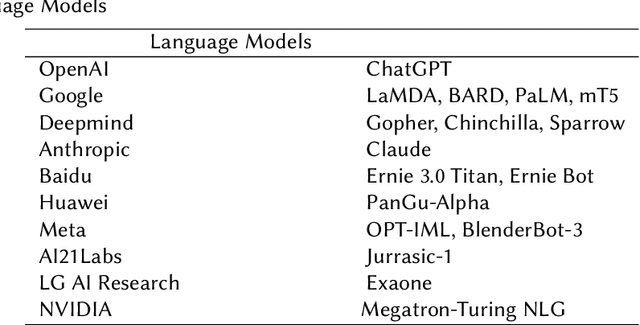
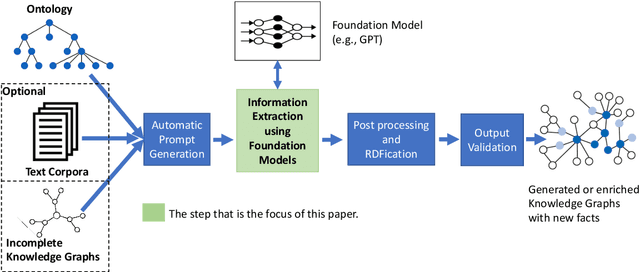
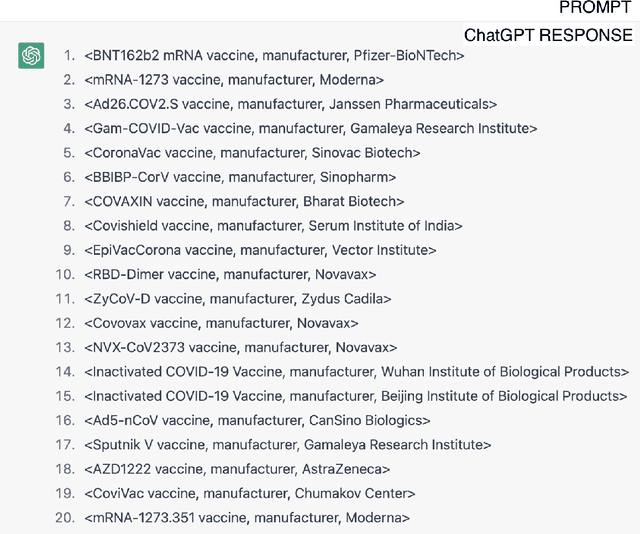
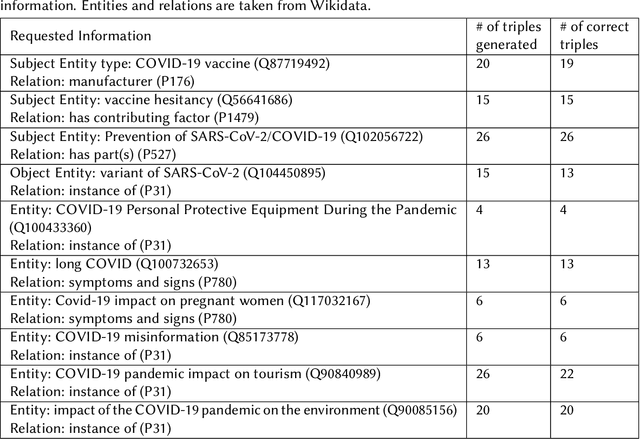
Abstract:Knowledge graphs can represent information about the real-world using entities and their relations in a structured and semantically rich manner and they enable a variety of downstream applications such as question-answering, recommendation systems, semantic search, and advanced analytics. However, at the moment, building a knowledge graph involves a lot of manual effort and thus hinders their application in some situations and the automation of this process might benefit especially for small organizations. Automatically generating structured knowledge graphs from a large volume of natural language is still a challenging task and the research on sub-tasks such as named entity extraction, relation extraction, entity and relation linking, and knowledge graph construction aims to improve the state of the art of automatic construction and completion of knowledge graphs from text. The recent advancement of foundation models with billions of parameters trained in a self-supervised manner with large volumes of training data that can be adapted to a variety of downstream tasks has helped to demonstrate high performance on a large range of Natural Language Processing (NLP) tasks. In this context, one emerging paradigm is in-context learning where a language model is used as it is with a prompt that provides instructions and some examples to perform a task without changing the parameters of the model using traditional approaches such as fine-tuning. This way, no computing resources are needed for re-training/fine-tuning the models and the engineering effort is minimal. Thus, it would be beneficial to utilize such capabilities for generating knowledge graphs from text.
Scaling Knowledge Graphs for Automating AI of Digital Twins
Oct 26, 2022Abstract:Digital Twins are digital representations of systems in the Internet of Things (IoT) that are often based on AI models that are trained on data from those systems. Semantic models are used increasingly to link these datasets from different stages of the IoT systems life-cycle together and to automatically configure the AI modelling pipelines. This combination of semantic models with AI pipelines running on external datasets raises unique challenges particular if rolled out at scale. Within this paper we will discuss the unique requirements of applying semantic graphs to automate Digital Twins in different practical use cases. We will introduce the benchmark dataset DTBM that reflects these characteristics and look into the scaling challenges of different knowledge graph technologies. Based on these insights we will propose a reference architecture that is in-use in multiple products in IBM and derive lessons learned for scaling knowledge graphs for configuring AI models for Digital Twins.
KnowGL: Knowledge Generation and Linking from Text
Oct 25, 2022
Abstract:We propose KnowGL, a tool that allows converting text into structured relational data represented as a set of ABox assertions compliant with the TBox of a given Knowledge Graph (KG), such as Wikidata. We address this problem as a sequence generation task by leveraging pre-trained sequence-to-sequence language models, e.g. BART. Given a sentence, we fine-tune such models to detect pairs of entity mentions and jointly generate a set of facts consisting of the full set of semantic annotations for a KG, such as entity labels, entity types, and their relationships. To showcase the capabilities of our tool, we build a web application consisting of a set of UI widgets that help users to navigate through the semantic data extracted from a given input text. We make the KnowGL model available at https://huggingface.co/ibm/knowgl-large.
 Add to Chrome
Add to Chrome Add to Firefox
Add to Firefox Add to Edge
Add to Edge